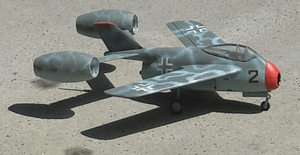Focke-Wulf Super Lorin
| Focke-Wulf Super Lorin | |
|---|---|
 | |
| Focke-Wulf Super Lorin model | |
| Role | Fighter |
| Manufacturer | Focke-Wulf |
| Status | Terminated by end of war |
| Primary user | Luftwaffe |
| Number built | None completed |
| Developed from | Focke-Wulf Ta 183 |
The Focke-Wulf Super Lorin was a German jet interceptor project. Designed towards the end of World War II by engineer Heinz von Halen, the project remained unbuilt before the surrender of Nazi Germany.[1] The Focke-Wulf Super Lorin remained only a factory design exercise, and never received an RLM airframe number.
Development
Not much is known about this project except that it was developed at the same time as the Focke-Wulf Ta 283. It was based on the Focke-Wulf Ta 183, with the same low swept wings at 45°, mounted on the mid-fuselage.
The aircraft would have a wingspan of 7.6 m and a length of 11.6 m. Power was to be provided by a rocket engine for takeoff and two Lorin ramjets located on the tips of the sharply-swept tailplane, which would be used for cruising. Armament was to have been two 30 mm (1.18 in) MK 108 cannon.[2]
See also
- Aircraft of comparable role, configuration and era
- Related lists
- List of German aircraft projects, 1939–45
- List of World War II Luftwaffe aircraft prototype projects
References
- ↑ Ernst Heinrich Hirschel, Horst Prem, Gero Madelung et al. Aeronautical Research in Germany: From Lilienthal Until Today, Volume 147
- ↑ Luft'46 - Focke-Wulf Super Lorin
External links
| Wikimedia Commons has media related to Focke-Wulf Super Lorin. |